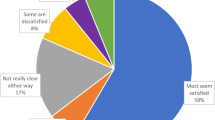Abstract
The Australian National Continence Management Strategy commissioned the implementation and evaluation of three community-based projects designed to improve care for people with incontinence by improving the detection and treatment of urinary incontinence. Projects were located in demographically diverse areas, overseen by co-operating professional groups with an interest in continence and aimed at facilitating a pathway of care for those with incontinence. Project activities focused on health care provider training and improving local referral networks, as well as raising public awareness. Multifaceted evaluation of each project was designed to inform principles for a national approach to continence care. The evaluation indicated that providers involved in each project became more confident in their ability to manage incontinence, had significantly increased knowledge of issues around incontinence and became more aware of local options for referral. However, there was little evidence that projects achieved an increase in seeking professional help among those with incontinence. From the evaluation, six principles were developed to guide future models of community-based continence care.

Similar content being viewed by others
References
Chiarelli P, Brown W, McElduff P (1999) Leaking urine—prevalence and associated factors in Australian women. Neurourol Urodyn 18:567–577
Cohen JR, Robinson D, Dugan E, Howard G, Suggs PK, et al. (1999) Communication between older adults and their physicians about urinary incontinence. J Gerontol 54:M34–M37
Fantl J, Newman D, et al. (1996) Urinary incontinence in adults: acute and chronic management. American agency for healthcare policy and research. US Department of Health and Human Services. Clinical Practice Guideline number 2, 1996 update. Public Health Service, Agency for Healthcare Policy and Research, Rockville, Maryland. US Department of Health and Human Services publication AHCPR 96–0682
Williams KS, Assassa RP, Smith N, Rippin C, Shaw C, Mayne C (2002) Leicestershire MRC Incontinence Study Team. Good practice in continence care: development of nurse-led service. Br J Nursing 11:548–559
Gunthorpe W (1998) Development of a general practice based treatment program for women with urinary incontinence. Doctoral Thesis, University of Newcastle, NSW, Australia
Sandvik H, Hunskaar S, Seim A, Hermstad R, Vanvik A, Bratt H (1993) Validation of a severity index in female urinary incontinence and its implementation in an epidemiological survey. J Epidemiol Community Health 47:497–499
Uebersax J, Wymnan J, Shumaker S, McClish D, Fantl J (1995) Short forms to assess life quality and symptom distress for urinary incontinence in women: the Incontinence Impact Questionnaire and the Urogenital Distress Inventory. Neurourol Urodyn 14:131–139
Larsen DL, Attkison CC, Hargreaves WA, Nguyen TD (1979) Assessment of client/patient satisfaction: development of a general scale. Eval Program Plann 2:197–207
Wallace SA, Roe B, Williams K, Palmer M (2004) Bladder training for urinary incontinence in adults (Cochrane review). In: The Cochrane Library, issue 2. Wiley & Sons, Chichester, UK
Grilli R, Ramsay C, Minozzi S (2002) Mass media interventions: effects on health services utilisation. Update of Cochrane database systematic review, 2000 (2). Cochrane database of systematic reviews
Acknowledgements
This research was funded by the Australian Commonwealth Government’s then Department of Health and Aged Care (now the Department of Health and Aging). The research team would like to thank all project staff and health care providers who participated in the Continence Care in the Community Project (Western Australia), the Hunter Continence Awareness Project (New South Wales) and the North East Victorian Continence Care and Resource Demonstration Project.
Author information
Authors and Affiliations
Corresponding author
Additional information
Editorial Comment: Understanding how public policy can influence both the provider practice and the patient care seeking behaviour in urinary incontinence is a very important, fascinating and timely topic. Numerous studies indicate that a minority of individuals with incontinence seek care from a health care provider and that many health care providers do not feel comfortable providing this care. Such characterisations are not limited to primary care. If we are to elevate the level of care that these patients receive, we must learn how to make care more accessible as well as more effective. This paper opens the door to the question of how to make care more accessible and we look forward to more like it
Rights and permissions
About this article
Cite this article
Byles, J.E., Chiarelli, P., Hacker, A.H. et al. An evaluation of three community-based projects to improve care for incontinence. Int Urogynecol J 16, 29–38 (2005). https://doi.org/10.1007/s00192-004-1208-y
Received:
Accepted:
Published:
Issue Date:
DOI: https://doi.org/10.1007/s00192-004-1208-y




